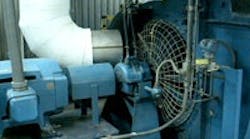The University of Texas at Austin’s 424-acre campus (UT) is the academic home to 50,000 students. Boilers and gas turbines at the Hal C. Weaver Power Plant provide year-round power, steam, chilled water, demineralized water and compressed air to approximately 200 campus buildings. In satisfying state air-quality compliance requirements, the plant reaped an unexpected $500,000 annual energy savings by retrofitting one 150,000-lb. boiler with an innovative system that reduced NOx emissions from 158 tons per year to 21 tons per year.
“Our objective as we began the boiler retrofit was to reduce NOx emissions, but the process resulted in us producing more energy with less gas by improving our combustion efficiency,” says Juan Ontiveros, director of utility and energy management at the school. “This allowed us to bank our standby boilers, saving us hundreds of thousands of dollars per year.”
The emissions-control system is Compu-NOx by Benz Air Engineering, Las Vegas (www.compunox.com). “We chose Benz Air to bring us into compliance because of its innovative and less expensive solution to the boiler retrofit,” says Kevin Kuretich, associate director, Utilities and Energy Management Department, UT. “Other vendors proposed similar solutions that involved flue gas recirculation (FGR) to cut down on NOx, but Benz was able to do the job without burner replacement — critical, because burner replacement — four on Boiler 3 and eight on Boiler 7 — was estimated to cost $2 million. We also chose Benz Air because we thought it had the most knowledge of the system and the expertise to upgrade our PLC/PC interface system.”
|
View more content on PlantServices.com |
Variable-frequency drives precisely adjust fan speeds to provide controlled flows of recirculated exhaust gas and air for combustion control.
The control platform controls airflows for precise metering by means of variable-frequency-drive (VFD) on fans instead of dampers. “The Compu-NOx control system uses the absolute linear relationship of fan speed to fan airflow as the basis of combustion control,” explains Robert Benz, president of Benz Air Engineering. “The system measures fuel flow and interpolates the correct fan speed to give the desired flow.”
Less horsepower is used to drive the fans, which results in significant cost savings from not running them continuously at full speed. “We have very precise airflow control, which makes all the difference in the world in fuel efficiencies and emissions,” says Ryan Thompson, project engineer, Utilities and Energy Management Department, UT. “We took Boiler 3 from 175 ppm NOx to less than 25 ppm without installing new burners, which would have been very expensive and required the boiler to be offline for several months. With Benz Air and Compu-NOx, all we had to do was change the fan power supply by using variable-frequency-drives to cut our emissions.”
The modification also included a separate recirculation fan and ductwork between the exhaust flue and the burner intake for FGR, which extracts flue gas from the boiler outlet duct upstream of the air heater and returns it through a separate duct to the combustion air duct that feeds the wind box. The slightly cooled combustion gas from the boiler exit is mixed back with the burner flame to reduce the peak flame temperatures — which reduces NOx.
The installation also provided the benefits of boiler banking: keeping the auxiliary boilers in a hot standby mode. “It allows us to keep one boiler at the ready, without using any measurable amount of gas,” Ontiveros says. “It’s a big advantage, saving us 30,000 pounds of steam per hour.” Turndown is in excess of 100:1 because of the VFD’s stable operating characteristic.
[pullquote]“In this case, the total rating for boiler 3 was 183 million BTU/hr,” Benz says. “UT is now operating it at less than one million BTU/hr input, or 183:1 turndown.”
Benz Air relies exclusively on ABB AC drives for its Compu-NOx system. The ACS800 uses ABB’s exclusive motor control algorithm called Direct Torque Control. “The ACS800 has a lot of communication flexibility that allows us to enjoy direct control of the AC drive digitally through the Ethernet back-up connection,” says Benz. “In the case of this university, we had to support several back-up systems to its communications and we were able to do that.
“Also of importance is the fact that the power factor for the drive is near unity, regardless of operating speed or load. By installing the drive, we are able to increase capacity of the transformer feeding it, so it saves the university from having to implement power factor corrections,” Benz says.
With energy and fuel costs soaring, UT’s payback on the system will be less than 12 months.
